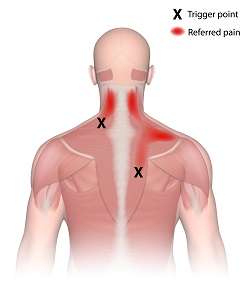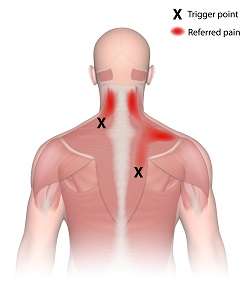
What is MFR Physiotherapy and its Techniques is the common question. Here we know about What Are The Best 6 MFR Physiotherapy Techniques and their uses.
Table of Contents
Definition of Myofascial Pain Syndrome (MPS) – What is the Best Treatment for Myofascial Pain
Myofascial Pain Syndrome (MPS) is a chronic pain disorder accompanied by trigger points in the muscles and the surrounding connective tissue, known as fascia. Trigger points are localized areas of hyperirritable points muscle fibers that can cause pain and refer sensations to other body parts. MPS often results from muscle overuse, trauma, or postural imbalances.

The pain experienced in myofascial pain syndrome is typically described as deep, aching, and persistent. The trigger points can cause local pain at the site and referred pain, meaning the pain is felt in areas away from the actual trigger point. These trigger points may also cause muscle stiffness, limited range of motion, and muscle weakness.
Diagnosis of myofascial pain syndrome involves a thorough physical examination, including palpation of trigger points to reproduce the characteristic pain patterns. Treatment for MPS often involves a multimodal approach, including manual therapies such as massage, trigger point release techniques, and stretching exercises to alleviate muscle tension and reduce pain. Other treatment options may include physical therapy, medications, dry needling, and lifestyle modifications.

Read More: Here you can also read about the comprehensive article The 12 Amazing Benefits Of Massage Therapy.
Sign And Symptoms of Myofascial Pain Syndrome – Manual Techniques in Physiotherapy
Myofascial pain can vary in intensity and location.
It is typically characterized by Trigger points or areas of hyperirritable muscle fibers within the fascia. The pain experienced can be described in several ways:
1. Localized pain: Myofascial pain is often localized to specific body areas, commonly in muscles or muscle groups. It can manifest as a deep, aching, or throbbing pain in the affected area.

2. Referred pain: Trigger points in the fascia can refer to other body areas, meaning the pain may be felt in a different location than the actual trigger point. For example, a shoulder trigger point may cause pain radiating down the arm.

3. Muscle stiffness and tension: Myofascial pain often accompanies muscle stiffness and tension. The affected muscles may feel tight, knotted, or restricted in their range of motion.

4. Pressure sensitivity: Trigger points can be sensitive to pressure, and applying pressure to these areas may reproduce or intensify the pain. This sensitivity is known as a “tender point” and is a diagnostic feature of Myofascial pain.

5. Pain with movement: Certain movements or activities that engage the affected muscles can aggravate Myofascial pain. The pain may worsen with muscle contraction, stretching, or sustained positions.
6. Muscle weakness: Myofascial pain may be accompanied by muscle weakness or fatigue in the affected area. IT can interfere with strength, coordination, and overall function.
7. Associated symptoms: Myofascial pain can sometimes be accompanied by other symptoms such as headaches, jaw pain, numbness or tingling, dizziness, or fatigue. These symptoms can vary depending on the specific Trigger points and referral patterns.

Consulting with a healthcare professional, such as a physical therapist or physician, can help diagnose and develop an appropriate treatment plan for Myofascial pain.
Causes Of Myofascial Pain
Myofascial pain can have various causes, and it often occurs when there are Trigger points or areas of hyperirritable muscle fibres within the fascia. These Trigger points can source local pain or refer to other body areas. Some common causes of Myofascial pain include:
- Muscular overuse or repetitive strain: Engaging in repetitive movements or activities that strain the muscles can lead to the development of Trigger points and Myofascial pain. It can happen in occupations or hobbies that involve repetitive motions or prolonged muscle use.
- Poor posture: Maintaining an improper posture for extended periods can cause muscle activation and load distribution imbalances, leading to Trigger points and Myofascial pain. For example, sitting or standing in a reclined position can strain certain muscles and contribute to pain in specific areas.
- Muscle trauma or injury: Direct trauma to the muscle, such as from a sports injury, car accident, or fall, can result in Myofascial pain. Muscle strains, sprains, or tears can also contribute to developing Trigger points and associated pain.
- Stress and emotional factors: Emotional stress, anxiety, and tension can contribute to developing Myofascial pain. Pressure can increase muscle tension and trigger point formation, especially in the neck, shoulders, and jaw areas.
- Post-surgical or post-injury muscle changes: Following surgery or an injury, muscles may change due to the trauma or immobilization. It can result in muscle imbalances, stiffness, and the development of Myofascial pain.
- Systemic conditions: Certain systemic conditions, such as fibromyalgia, rheumatoid arthritis, or chronic fatigue syndrome, can be associated with Myofascial pain. These conditions may involve widespread pain and muscle tenderness.
Myofascial Release (MFR) Physiotherapy
MFR Physiotherapy, or Myofascial Release Technique, is a manual therapy( hands on) approach to release tension and tightness in the body’s fascia, a connective tissue surrounding and supporting muscles, bones, and organs. Fascia can become restricted due to various factors such as injury, trauma, poor posture, or repetitive motion.

During a MFR Physiotherapy release session, a trained therapist applies gentle, sustained pressure, stretching, and manipulation to the affected body areas. The therapist uses their hands, fingers, knuckles, or specialized tools to locate and treat areas of fascial tension or adhesions. The pressure is applied in a specific direction, allowing the fascia to elongate and release.

MFR Physiotherapy aims to improve the range of motion, relieve pain, and restore optimal functioning of the muscles and fascia. It often addresses musculoskeletal conditions such as chronic pain, sports injuries, headaches, and postural imbalances.

Techniques of Myofascial Release
MFR Physiotherapy has many techniques in which therapist use skin rolling, traction, or deep tissue massage to address deeper fascial restrictions. They work with the client’s body, using feedback and communication to guide the treatment process and ensure comfort and effectiveness.
- Active Release Technique (ART): This technique involves the application of precise and specific tension, combined with active patient movement, to targeted areas of the body. This technique aims to break up scar tissue and adhesions, improve the range of motion, and alleviate pain by restoring normal tissue function.
- Passive Release Technique: In this technique the therapist applying controlled pressure and stretches to specific areas of the body without the patient’s active involvement. The therapist manipulates the soft tissues to release tension, reduce muscle spasms, and improve flexibility. This technique often addresses muscular imbalances, postural issues, and musculoskeletal disorders.
- Transverse Massage: Transverse massage, also known as cross-fiber friction massage, is a technique that involves applying deep pressure across the muscle fibers. The therapist uses their fingers, hands, or a massage tool to create transverse movements that penetrate deep into the muscle tissue. This technique aims to break up scar tissue, release adhesions, increase blood flow, and promote healing in the affected area.
- Functional Massage: A functional massage is a therapeutic approach that focuses on restoring available movement patterns and addressing specific dysfunctions in the body. It involves applying various massage techniques, such as kneading, compression, stretching, and joint mobilization, to target specific muscles, soft tissues, and joints. Available massage aims to improve overall movement, reduce pain, and enhance performance in daily activities or sports.
- Strain Counter Strain Technique: Strain Counter Strain Technique, also known as Positional Release Technique or Tender Point Technique, is a gentle and passive therapy that relieves pain and muscle spasms by releasing tender points or trigger points. The therapist identifies tender points and places the affected muscle or joint in a position of ease where the tension is reduced. By holding this position, the therapist allows the muscle or joint to reset, relieving pain and restoring proper function.
- Kneading Release Technique: This technique involves rhythmic, circular movements using the hands, thumbs, or fingertips to compress and manipulate the soft tissues. The therapist applies pressure to the muscles and tissues, alternating between kneading, rolling, and squeezing. This technique aims to increase blood flow, relax muscles, reduce tension, and promote relaxation and well-being.
Benefits Of MFR Physiotherapy
The objectives of MFR Physiotherapy release therapy include:

- Pain relief: By releasing tension in the fascia, the treatment aims to alleviate pain and discomfort caused by tight muscles, Trigger points, or restricted movement.
- Increased range of motion: By improving the flexibility and pliability of the fascia, Myofascial release therapy can enhance joint mobility and restore normal movement patterns.
- Relaxation and stress reduction: Myofascial release therapy’s gentle pressure and stretching techniques can induce relaxation, promoting well-being and reducing stress.
- Improved posture and body alignment: Myofascial release therapy can help realign the body and improve overall posture by addressing fascial restrictions contributing to poor posture.
- Release of fascial restrictions: By applying sustained pressure and stretching, MFR therapy aims to release tension, tightness, and adhesions within the fascia, allowing it to return to its normal, pliable state.
- Improved range of motion and flexibility: By addressing fascial restrictions and restoring normal tissue mobility, MFR therapy can help increase range of motion, flexibility, and ease of movement.
- Enhanced body awareness and relaxation: The hands-on nature of MFR therapy can promote body awareness and relaxation, allowing individuals to connect with their physical sensations, emotions, and patterns of tension.
- Overall well-being: MFR therapy is believed to have a holistic effect on the body, mind, and spirit, promoting balance, well-being, and vitality.
- Enhanced athletic performance: Many athletes and sports enthusiasts incorporate Myofascial release therapy into their training regimen to optimize performance, prevent injuries, and aid recovery.
Contraindications of MFR Physiotherapy
Myofascial release therapy is generally safe, but there are situations in which it may not be suitable. It is essential to consult with a qualified healthcare professional or licensed therapist before undergoing this treatment. Here are some factors to consider:
- Acute injuries or inflammation
- Open wounds or skin infections
- Blood clotting disorders (DVT)
- Cancer or metastasis
- Severe osteoporosis or fragile bones
- Pregnancy
- Infections or systemic illnesses
Frequently Asked Questions About MFR Physiotherapy
Q: What does active versus passive Myofascial release entail?
Ans: Direct and indirect Myofascial procedures can be categorized as passive (patient remains entirely relaxed) or active (patient offers resistance as needed).
Q: How does Myofascial categorization work?
Ans: Latent Trigger points and active Trigger points are the two categories. An activated trigger point experiences spontaneous pain or discomfort in reaction to movement and can cause transferred or local pain. A latent trigger point is a sensitive area that only becomes painful or uncomfortable after being compressed.
Q: What is the scientific name for Myofascial pain?
Ans: Patients with musculoskeletal pain issues may have Myofascial pain syndrome (MPS). Muscle and the surrounding fascia are the sources of the pain associated with MPS. Patients typically have referral pain in diverse patterns or localized pain in a constrained region when they first appear.
Q: What distinguishes soft tissue from Myofascial release?
Ans: To facilitate deeper healing and general well-being, soft tissues are worked on. To loosen restricted mobility, Myofascial release depends on stretching and manual pressure. When an injury happens, when you lose flexibility or function, it can be quite beneficial since it addresses a variety of ailments and symptoms.
Q: What distinguishes direct and indirect OMT approaches from one another?
Ans: The two types of treatments are “direct,” in which the doctor works on the patient’s limited range of motion, and “indirect,” in which the patient’s body is put in a comfortable posture while receiving therapy.

Very informative
It’s very helpful and informative